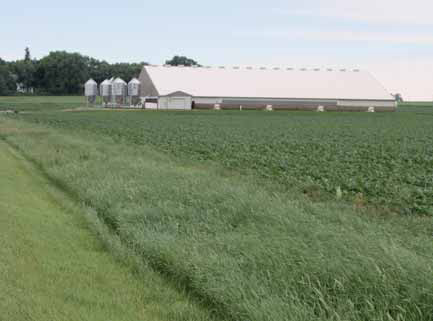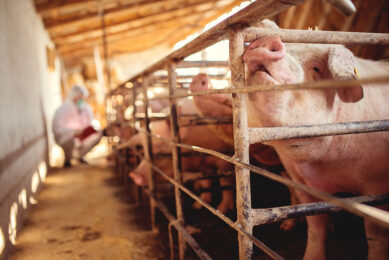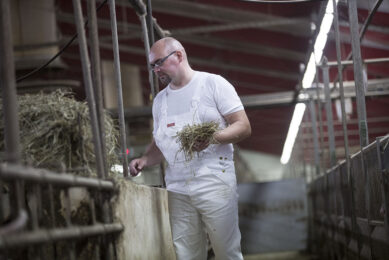Phytase – for the environment and for profits

The use of feed enzymes offers solutions to reduce the cost of manure disposal and improve the sustainability of pork production as measured by environmental indicators from a life cycle assessment.
It is estimated that approximately 25% of the human impact on global warming is related to food consumption. In the EU meat and dairy consumption alone account for 14% of the global warming effects. Furthermore, meat and dairy production for consumption is responsible for 25% of the total acidification and 47% of the total aquatic eutrophication within the EU.
Thus, the desire and choice of humans to consume meat is a determining factor in the overall environmental impact of our activities. A range of assessment tools have been developed to establish environmental indicators and thereby measure the impact of our activities on these indicators. Part of this process involves the determination of the environmental impact of livestock and agricultural production systems.
In Life-Cycle appraisal, the ‘cradle-to-grave’ approach is adopted to reduce a product’s cumulative environmental impact. The Life Cycle Assessment (LCA) is a method of evaluating a product’s resource use and environmental impact throughout its life cycle. In LCA all relevant emissions and resources used from the inception, through production, use and disposal (i.e. its ‘Life-Cycle’) are aggregated and expressed per unit of the considered product. Commonly applied environmental impact categories within LCA of food products are global warming, eutrophication and acidification (see box). For each of the environmental impact categories the emitted substances that contribute to that environmental impact category are quantified.
LCA in pork production
The preliminary results of a life cycle assessment of the environmental profile of the European pork sector show that the total contribution from the production of 1 kg of pork product was 5.3-5.7 kg CO2 (carbon dioxide) equivalents for global warming and 0.27-0.34 kg NO3 (nitrate) equivalents for eutrophication. Benchmark values for global warming for many vegetables are less than 0.3 kg CO2 per kg product, which illustrates the importance within the pork sector of addressing this question. Table 1 compares the environmental impact of pork production in Denmark to that of the UK on the basis of two separate published studies. Daalgard (2007) studied the environmental hotspots – the parts of the product chain that impact the environment the most in the Danish pork production chain, using LCA. Figure 1 shows that the fattening pig farm and weaner supply were the two most important environmental hotspots for global warming, eutrophication and acidification. The most important pig farming contributions to eutrophication are nitrates, ammonia and phosphates.
LCA carried out in UK pig production systems with slatted flooring demonstrates that the highest contribution to eutrophication is slurry/manure application to land. Its contribution is 0.031 kg PO43- (phosphate) equivalents, accounting for 53% of the total eutrophication potential.
Economics of regulations
One of the challenges of implementing regulations or recommendations to control agricultural pollution is to evaluate the economic impacts on the livestock sector. Phosphorus-based nutrient management regulations require that manure application be limited to the phosphorus (P) needs of the crop, preventing soil P accumulation and resulting run-off into water systems. Most livestock farms produce more manure P than their crops require, and these P-based plans will often demand that the excess manure be disposed of in other ways, or on other areas of land.
Under these circumstances the costs of excessive P supplementation and P excretion are much greater than just an increased feed bill for the farmer. These additional costs include the transportation of manure that is in excess of what can legitimately be applied to land and, potentially, subsequent disposal fees.
In the Netherlands the disposal of manure currently represents 5% of pig production costs. The costs in the Netherlands are markedly higher than in other European countries and are set to increase further between now and 2013. These costs amount to €0.23/kg slaughter weight. Manure disposal costs are highest where pig densities are at their greatest and cropland for spreading manure high in P concentration is not as available. Farms with a small land base relative to animal numbers will face a higher cost of compliance because they are more likely to have to pay third party contractors to remove excess manure which cannot be spread due to lack of land availability. Manure management costs will also vary between operations of different sizes. These expenses are based on ownership structure and type of manure handling system and whether cropland operators are willing to accept or pay for manure.
As a result, feed formulations should also take into account the effect of feed composition on manure disposal costs to minimise total pig production costs.
Effective use of phytase
Phytase application to pig feed improves the availability of phytate phosphorus, which is naturally occurring in plant material and, effectively, indigestible. The improvement in bio-availability of naturally occurring phosphorus via the use of phytase means that less inorganic mineral P needs to be added to the feed and less P will be excreted in the manure, reducing feed costs and environmental impact.
A recent study carried out by Haus Düsse in Germany demonstrated that monocalcium phosphate supplementation could be completely replaced with phytase application in a mixed grain diet, without detrimental effects on performance and bone mineralisation in fattening pigs (29-120 kg). Results from the same study (Table 2) show a significant reduction in P excretion in manure (-35%) and the area of land required per 1,000 pigs (-35%).
Nielsen & Wenzel (2006), who used the LCA approach, showed that if inorganic phosphorus in pig feed was replaced by phytase, global warming, acidification and eutrophication would be 17, 110 and 700 times lower respectively, compared to a situation where higher levels of monocalcium phosphate were used. Figure 2demonstrates that the biggest environmental impact from monocalcium phosphate (MCP) is on eutrophication.
Economics of phytase use
Studies, including economic analyses carried out in Canada and the US, have shown that adding phytase to pig diets helps to reduce the incremental costs resulting from compliance with environmental regulations based on P-restriction and from the rising cost of MCP, which in turn is linked to rising oil prices.
The Manitoba Livestock Manure Management Initiative in Canada compared the incremental cost per marketed pig of compliance with different phosphorus manure management strategies for farms with and without phytase in their feed. For the strategies where no extra land was available and manure needed to be transported over a certain distance, increased cost per marketed pig averaged $1.20 in fattening pig operations.
By adding phytase to the pig feed, the additional cost of complying with the nutrient standards could be decreased by around 43% on average. Survey data used to assess the economic impacts of alternative regulations on manure application on Heartland pig farms in the US revealed that P-based restriction would increase pig production costs and could affect the financial well-being of pig producers (Huang and others, 2003).
The impacts were relatively greater on the large-sized farms (over 2,500 pigs) than on the medium-sized farms (between 750 to 2,500 pigs). Feeding pigs a phytase supplemented diet to decrease phosphorus in manure reduced both the additional land needed and the manure application costs. PP











